Zanzibar is home to several types of habitats. Depending on the types of ecosystems you might be interested in, you can potentially explore them all during your trip to Zanzibar. Each of these ecosystems is an important part of the environmental balance that makes up the country. Here are some of the top descriptions of the habitats in this area as well as what you can expect.
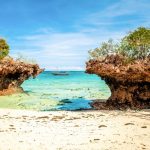
Sandy and rocky coasts
Zanzibar is home to some beautiful beaches for swimming. Throughout the coastline you can find many of the world’s most beautiful beaches some of them are rocky where as others take on a more Sandy appearance. Whether you are visiting Zanzibar for diving or to soak in the sun, these ecosystems can prove an excellent place to stay over the time that you are in the area.
Sandy beaches and rocky coasts are responsible for supporting a number of different endangered species. Without these beautiful coastlines we would not have some of the world’s most endangered sea turtles. These majestic animals use the Sandy coastlines throughout Zanzibar to lay their eggs as well as for some shelter from the sea. These turtles breed on the island every year and roads through the coastline are protected and regulated to ensure that these animals are not put at unnecessary risks.
The coastlines to the north are less susceptible to tidal flows and as a result the sand here tends to be finer not dragged away by the ocean regularly. This is a very popular place for many animals and a fantastic area for spending an afternoon sunbathing.
Low tide pools created on the rocky shores sustain a number of small anemones, starfish, minnows and more. These unique tide pools give life to some of the world’s most interesting species that could not normally survive in large open ocean environments.
These tidal pools as well as the sands themselves also attract a number of unique shorebirds to the area. These animals would be unable to sustain themselves without feasting on the various animals that choose to live in the sand as well as in these tidal pools.
While there are both rocky coasts and Sandy Coast throughout Zanzibar they are absolutely essential to the animals that live in each region as well as for maintaining the full group of ecosystems that make up the area.
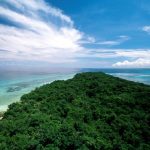
Coral Rag Forest
Coral rag forests can actually grow in areas which experience a lower amount of rainfall. This type of forest in Zanzibar is much more resilient to weather conditions and they can last over many generations. In most cases these forests can grow directly out of limestone which is a porous rock. As water drains away from this material quite quickly the trees and plants from the area have become particularly well adapted to standing up to living without much in the way of rainfall.
The coral rag Forest in Zanzibar can be found just southeast of Unguja. What is surprising about this type of forest is that they are generally nonrenewable resources that sit in an extreme balance. Although coral rag is quite resilient, as people begin to remove these plants from the area it can sometimes take millions of years before the same types of plants can continue to evolve and stay. Coral rag Forest dates back millions of years and they were likely some of the first plants in this area. Quite unfortunately many people take away these forests as materials in a variety of construction projects and more. As these plants are picked and removed they are virtually irreplaceable. As many people in the area depend on coral rag, sand and sediment from the surrounding area efforts are being made to change the way that these materials are harvested. Considering this region was likely at one point covered with a wide array of this coral rag Forest, the total amount of this plant has diminished significantly impacting animal populations as well as the ecosystem as a whole.
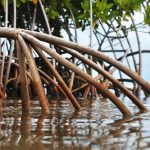
Mangroves
Mangrove trees can be found throughout Zanzibar and they have a number of amazing uses by both animals as well as the people in the area. The islands of Zanzibar house over 18,000 ha of mangrove forest. Not only are they responsible for balancing out ecosystems by preventing erosion but they are highly valued for food, building materials and more.
Mangroves in Zanzibar are generally protected and red mangroves especially are resilient plants that are capable of floating for up to a year before they start their growth.
Mangrove populations protect the soil against erosion and they can create an amazing barrier that protects the entire area of Zanzibar even in extreme conditions. Properties are located close to mangrove forests for example generally experience far less damage because of the natural barrier that these trees can provide over time. On a global scale however mangroves are valued for their forestry rights. It’s estimated that in the US a mangrove can collect up to $900 per hectare when traded. The locals however do depend on mangroves for food, for protecting their land and for their overall livelihood.
Mangroves are responsible for protecting many species of fish from predators as well as marine animals. A number of endangered species can live in mangrove roots to protect themselves as they grow and this can be an essential aspect of any ecosystem especially with crabs, prawns and other types of fish as they need to reach maturity in a safe environment in order not to die out entirely.
Mangroves also play a huge role in protecting coral species. They can act as a filter for sediments which can smother and kill off various coral and seagrass. Many mangrove forests have grown over thousands of years to protect coral species and unique seagrass beds which sustain large fish populations. These reefs are responsible for greater fish catching for local populations as well as for habitats on many creatures.
Mangroves are a huge population support feature for several different species of mammals like the red Colobus monkey, lobsters, mudcrabs, worms, lizards, snakes, insects and sponges. These trees represent a prime habitat choice for many of these animals and as they are removed hundreds of potential species could be put at risk.
Mangroves are also a huge ally for climate change. Restoring mangrove forests can do a lot for reducing greenhouse gas emissions and because the trees can grow so readily in a variety of environments they can continue to impact climate change in Zanzibar as they are planted sustainably.
The biggest issues that mangroves face in Zanzibar is a deforestation effort for building materials, hotel developers creating new beaches and waterfront locations, mangroves being used as fish traps, salt production damaging mangroves, land reclamation for expanding populations as well as ongoing pollution and oil spills. Each one of these potential threats could deliver a huge blow to the success of these amazing plants.
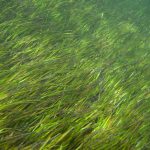
Seagrass beds
Seagrasses our various plants that are found throughout Zanzibar and they can be both flowering marine plants as well as mango tree plants and seaweed. Seagrass breads take on many forms including the look of algae and with around 60 different species that can be found throughout the world as well as 13 that can be found in Zanzibar, these plant materials are responsible for creating a sustainable ecosystem for many of Zanzibar’s plants and animals.
Seagrass has obtained its name because many of the top species of this plant look very similar to the type of grass that you might see on land only it is capable of growing in sandy areas and bog areas. With some types of seagrass that resemble the look of ribbons and some that look like lily pads, these plants are responsible for not only preventing erosion but for feeding a variety of animals who live in coastal environments.
Most of the lifecycle of the plant takes place in a wet environment. Seagrass beds can actually reduce asexually and the way that the seeds germinate varies from species to species. You can find seagrass in areas where there is might as well as in shallow lagoons throughout Zanzibar. You can often see several different species of seagrass growing together in a cluster. Most of the time top seagrass is responsible for growing together in areas where the waves do not produce fairly strong currents. These grasses are responsible for trapping water when the tide leaves and many of the plants require this moisture to survive while the tide is out.
Some of the best seagrass grows up to around 25 m in length throughout Zanzibar and this can produce food as well as some huge benefits to the area and the ecosystem. Although a seagrass bed may not seem to be much of a contribution to an ecosystem environment, they can support a wide range of marine animals.
Seagrass beds are responsible for maintaining the health of mangroves, coral reefs, rabbit fish, cockles and more. Many young fish actually grow up sheltered by seagrass for support from predators. Shelfish and a number of small crustaceans also depend on seagrass to live and for their only source of food. Seagrass can also be eaten by people as well. Many people in local areas continue to harvest seagrass and shellfish in order to eat them for food.
Seagrass is are responsible for actually stabilizing the floor of the seabed and preventing various sediment from making its way to cover up coral reef and destroying a number of unique plants and animals.
Photosynthesis through seagrass is actually a big part of what reduces carbon dioxide from the environment as well. When seagrass is in place it possible for carbon dioxide levels to be contained and to ensure that the sea remains balanced is not to dissolve coral and bleach it.
Seagrass is washed up on shore after they die and they work remarkably well for actually stabilizing the sand as well as protecting the coast from eroding away. Without seagrass is the coast of Zanzibar would not have its famous beaches. The plants in this area after they die will also help to feed a number of different organisms as well as continue to stabilize the plants that are around the coastline.
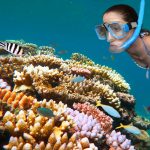
Coral reef
Coral reefs are a very large part of Zanzibar’s tourism as well as the ecosystem of the marine area. The coral reefs in Zanzibar are some of the most spectacular sights for keeping animals and ecosystems well-balanced. Most corals form in colonies from very small animals known as polyps. Polyps start as a small jellyfish like creature that drifts through water currents and eventually produce their own unique type of algae. Through photosynthesis a polyp can eventually turn into a host for a wide range of other animals. Coral species require a special sea temperature between 23 to 29°C in order to survive and they usually can be found between 2 to 30 m in tropical seas.
As coral polyps continue to die off and produce skeletons, new polyps will grow on top until eventually a large body of coral is formed over a reef like formation. Coral can eventually take on many different formats and become a living creature on its own. The wide collection of skeletons take on many shapes ranging from domes to shelves, trees and more. You can often find small patch reefs throughout Zanzibar as well as barrier reefs which are well separated from the shore.
A coral reef stands as one of the most interesting and diverse ecosystems that can be found in our world. Many of the world’s largest coral reefs are protected and Zanzibar has a number of coral and reef species that can only be found in this area of the world. With some reefs that contain hundreds of different species all in one formation, Zanzibar has over 200 different types of coral and 432 different reef fish to be found throughout the area.
Coral reefs are important because they provide an overwhelming amount of shelter to the marine species of Zanzibar. As fish are responsible for around 60% of the protein eaten by local people in Zanzibar reefs are needed to create a sustainable fishery. Many smaller fish spend their early days in the reef and some species of fish live exclusively in these reefs as well.
With many fishermen depending on reefs in order to catch their quota of fish each year, these reefs represent the livelihood and living conditions for the people of Zanzibar.
Coral reefs work for their natural beauty as well as tourism attractions as well. Around 20% of the GDP in Zanzibar is directly related to the coral reefs and the tourism industry. If the reefs were to disappear it could be possible that tourism dollars would be soon to follow.
A protective barrier: coral reefs act as a protective barrier for the sea which can protect the land from a various amount of storms as well as erosion in the sea floor. This type of protection is ideal for protecting Zanzibar from various flooding disasters, storms and more.
Coral polyps also ensure that climate change can be slowed down through the procedure of carbon fixing. As limestone skeletons for polyps begin to break down and get dissolved in seawater, this can also reduce the effects of climate change by controlling carbon dioxide in the atmosphere.
Some of the greatest threats to coral reefs throughout Zanzibar include overfishing methods as well as distractive fishing. Many fishermen continue to overharvest species like lobster, crabs and octopus which continue to support the reef. Parrotfish for example when they are overfished or unable to grind and release sand from various elements of the coral which allow them to expand. Some destructive fishing methods including dynamite fishing also drastically damage coral populations and ruin this ecosystem.
Invasive species can also be a huge concern for the ecosystem such as the crown of thorns starfish. This type of starfish is known for feasting on polyps directly and occasionally when overfishing occurs there is a lack of predators which produces excess numbers of this type of starfish which is responsible for wiping out coral reefs when their populations grow.
Divers can also potentially damage to coral reefs by interacting with the coral, kicking sand on the coral and even removing coral for souvenirs. Boats for divers can also damage coral if the organizers of diving excursions are not careful with their propellers or their diving expeditions. Dredging for boats can also lead to siltation which can cover coral in sediment and kill it off.
The reduction of various seagrass is and mangroves can also cause siltation which can starve coral out.
Coral is also regularly mind for the use of lime construction and this involves heavy harvesting of coral reefs which do not recover.
Climate change is also a massive concern for coral reefs as coral bleaching can occur during extreme weather events. As water changes temperature or experience reduction in salt levels bleaching can occur when corals eject the algae that they need to survive. Coral bleaching is happening around the world as well as in Zanzibar and it is unfortunately a disease that continues to spread especially during massive climate change events.
Acidification in the ocean can also cause a major reef break down as there is a breakdown of the calcium carbonate or limestone that makes up the skeleton of a coral reef.
Protection on coral reefs is a critical part of keeping this environment a safe one for the future of ecotourism as well as for the people in this region of the world.
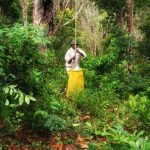
Groundwater forest
Forests can have a massive effect when it comes to regulating groundwater levels throughout a variety of ecosystems. In Zanzibar this fact is even more influenced by the various wild forests that are located throughout the area.
Groundwater forests are not only ample habitats for many types of butterflies, bees, monkeys, and more. But the people depend on the larger trees and groundwater forests to make sustainable construction materials as well as often to have cooking fires and more. Many groundwater forests and mangrove trees are felled in the creation of coal and other materials which are commonplace in this area.
Quality vegetation like groundwater forests can actually slow down the effect of water as it flows over the ground and back into the ocean. Without access to quality vegetation it’s also difficult to have any type of barrier to carbon emissions. As more deforestation occurs we are continuing to see huge impact on the surrounding environment in animal populations as well as in air quality and the quality of products throughout Zanzibar. Without quality plant is difficult to have a highly oxygenated environment which is capable of sustaining the same level of life and balance.
Forests throughout East Africa are some of the largest forest areas in the world for their bio diverse city. The moist and green forests throughout the mainland of Zanzibar grow very tall and produce extremely for tile soil when left untouched. Mangroves and other types of tree species can grow quite fast in this area and these types of forests are heavily responsible for providing homes to mammal species, bats and more. Over 177 different species of birds also called these forests their home and with a deforestation effort it can be easy to see some of their numbers beginning to decline.
Habitat loss in clearing these forests for quarries, resorts, living arrangements as well as for production is making a huge impact on the environment and changing the way that cultivation occurs in the area. Without the trees and plants to support the quality soil, good composition is changing and it doesn’t offer the same growth rates for agriculture as it does for the natural plants in the area.
Cutting down these forests also has an overwhelming effect on erosion. Without groundwater forest it’s easy to start to see extensive flooding during heavy storms as well as areas of the beach in Zanzibar being washed away by the tides and heavy seas. This is a phenomenon that simply has not been seen before but is growing in frequency due to the massive amount of deforestation going on.
The increasing standing water in deforested areas is also causing mosquito populations to grow in size as well affecting the rest of the wildlife.
With so many different habitats scattered across Zanzibar, it is not only easy to see the benefits of one habitat over another but it is important to remember that every habitat coexists to create the fragile ecosystem that has bene put in place for thousands of years for the plants, animals and people in this area.

